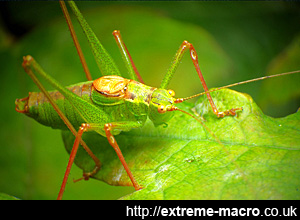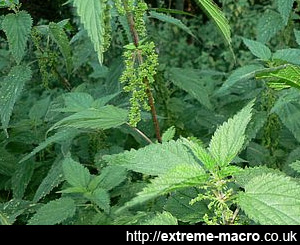Finding Insects
by Johan J Ingles-Le Nobel
Last updated August 31, 2017
Finding insects for photography can be quite a challenging endeavour, but there are certain ways that you can increase the chance of coming across your favourite insect.
Some of these may very well be perfectly obvious, but sometimes the obvious is all too easy to forget.

Insects - there are billions of billions of them about, but whenever you want to go and photograph one you can never seem to find them. The insect season really starts in March and finishes in October in the UK, and during the winter months is a good time to take out your preserved specimens and try some macro stacking inside.
Morning Macro
Early morning are a fruitful time to go out for the extreme macro stack because, being chilled, insects will stay relatively still, enabling you to do a field stack with only the minimum of specimen movement. But there are other good reasons to go out early, and make sure that you've got the right gear with you!
Find Water
Insects need vegetation, and vegetation needs water. So by going towards where there's plenty of water, you'll increase the amount of insects that you come across as well.
Try Night Macro

Another really good place to look for some insect diversity and quantity is your local nearest nettle patch. I often visit the allotments near my house which are surrounded by nettle patches, and the insect diversity flying around in the nettles is excellent. Look under the leaves as well as on top, and wear thin gloves!
Extreme macro doesn't just need to be shot during the day, and the nighttime brings out a whole different category of insect to the day macro. Use a decent torch or a decent ringflash to give you the illumination that you need for night macro. More about night macro.
Using Insect Lures
Of course you can always cheat a little - instead of going to the insect, make the insect come to you using food, scent, chemicals and other lures from industry and biology.
Planting for Insects
You could always plant some stuff in the garden for insects and the Internet is full of webpages suggesting good plants to plant for insects. But just about all of these pages talk about small plants in borders, whereas planting a small tree that grows up and is the same as having a 100m insect-attracting border in the garden is surely a much more space-efficient manner in which to find insects. There is such a tree.

Meadow grasses on Ranmore Common, a large grassy hillside near where I live which is absolutely swarming with insects in the summer.
Catching Insects
If you're trying to actually catch the insect rather than find them to photograph them in the field, an insect trap of some description maybe a better option.
I have, at various times, used sweep nets, pitfall traps, a Robinson moth trap, a tropical butterfly trap and beating for insects to find my specimens, all of which are useful methods in the insect photographer's arsenal.
Old Logs
We have an open fire in our house so we regularly buy in old logs to burn. If you have a large garden, consider making a pile of old logs in one corner and then just let them sit there and rot for a year or two. Beetles absolutely love old logs - these log piles are literally swarming with them.
Edges
Life lives on the edge. There tend to be more insects at the border where the field meets the forest than inside the forest or inside the field. I don't know why this is true, but it is.
Look For Evidence
Sometimes you just can't find any insects. This is the time to start looking for the evidence of insects rather than the insects themselves - leaves that have been eaten, for example, will give you a great clue where there might be an insect hiding underneath.
Spring
Spring is without doubt the best time for insect activity. My numbers are 3-4 times more increased during the spring than during any other part of the year. And with sunrise at a relatively civilised time, it is also not to painful to get up out of bed early for some photos.
Related Articles





